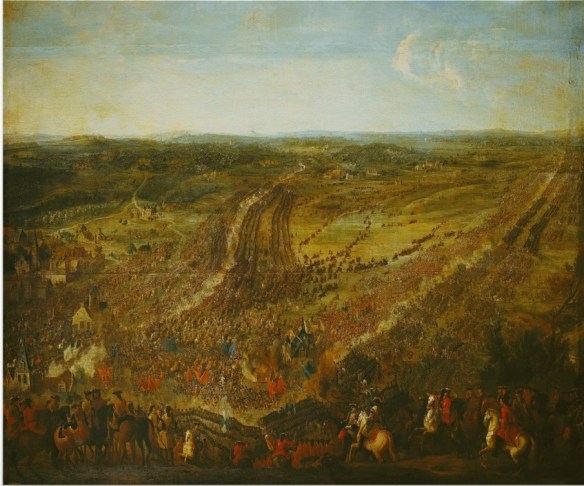Prince Waldeck commanded the main Allied army in Flanders in 1690, while the French were generaled by maréchal Luxembourg. After much maneuvering, the French approached Fleurus at the end of June, where the Allies stood waiting. French dragoons swam the Sambre River, taking a key crossing from the rear. The rest of the army followed, guaranteeing a battle. Waldeck had positioned his Allied force of some 38,000 (or more) in traditional line of battle. Two long lines of infantry were protected by cavalry, with the center of his line braced against the gentle waters of the Orme. Luxembourg had just 35,000 men, but still chose to attack. The French were unable to make a frontal assault because of the strong Allied center position behind the River Orme. Luxembourg hence divided his army to advance simultaneously on both enemy flanks. He used the highly unorthodox and risky tactic of splitting his army and marching in columns nearly within range of the enemy line. He was able to carry this off because the maneuver was mostly blocked from enemy view by broken terrain, and because Waldeck could not imagine that Luxembourg would dare to do it. He crossed the Orme unobserved on pontoon bridges thrown up by French engineers, his infantry still in column formation but protected by a heavy screen of cavalry and the terrain.
Fortuitous timing of this double march meant that Luxembourg’s columns arrived and deployed into line on both flanks at nearly at the same time, around midmorning. Luxembourg opened with his artillery, some 70 guns, then ordered the cavalry to charge, closely supported by infantry. The French left was bloodily repulsed, but the attack on the right made headway as shells and musket balls coming from multiple directions confused and demoralized the Dutch and their Allies. Heavy fighting lasted for nearly three hours, though the outcome was seldom in doubt. Waldeck’s lines broke and were rolled up, though he managed to re-form a firing line to the rear. This line was assaulted in turn by French cavalry and then by advancing infantry, and it broke around 2:00 P. M. The Allies suffered 20,000 total casualties, of whom over 6,000 were dead and nearly as many wounded, with 8,000 taken prisoner. Luxembourg lost 3,000 men and another 3,000 wounded, and no prisoners. That was a total loss of 20% of all effectives to death or wounds, from a total of 73,000 men engaged, after just a few hours of fighting.
Prince Georg Friedrich of Waldeck, (1620-1692)
Imperial prince and Feldmarschall. As a young soldier seeking fortune and favor, he fought for the Dutch during the Thirty Years’ War (1618-1648). He was clever and commanded respect from many north German princes, successfully bringing them into a defensive coalition with Brandenburg and Sweden, and later with the United Provinces. He fought for Brandenburg in the 1650s and for Sweden in the 1660s. That service helped secure his own scattered hereditary claims and assets within the Empire and, via his marriage into the Nassau-Siegen family, in the Netherlands. During the Dutch War (1672-1678), he fought for German princes and under Charles V of Lorraine. This again helped secure his lands from claims by avaricious neighbors, though it did not protect them from scorching. Waldeck was one of the closest military and strategic advisers to William III (then still Prince of Orange) in the 1680s. He took command of Dutch forces during the opening years of the Nine Years’ War (1688-1697). He defeated a French army at Walcourt (August 25, 1689). However, he lost badly at Fleurus (June 21/July 1, 1690). He died in 1692.
